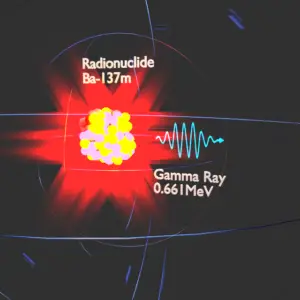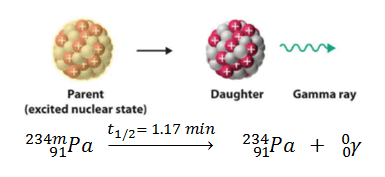Gamma decay or γ decay represents the disintegration of a parent nucleus to a daughter through the emission of gamma rays (high energy photons). This transition (γ decay) can be characterized as:
As can be seen, if a nucleus emits a gamma ray, atomic and mass numbers of daughter nucleus remain the same, but daughter nucleus will form different energy state of the same element. Note that, nuclides with equal proton number and equal mass number (thus making them by definition the same isotope), but in a different energy state are known as nuclear isomers. We usually indicate isomers with a superscript m, thus: 241mAm or 110mAg.
Isomeric Transition

In certain cases, the excited nuclear state that follows the emission of a beta particle or other type of excitation, are able to stay in metastable state for a long time (hours, days and sometimes much longer) before undergoing gamma decay, in which they emit a gamma ray. These long-lived excited nuclei are known as isomeric states (or isomers) and their decays are termed isomeric transitions. The process of isomeric transition is therefore similar to any gamma emission, but differs in that it involves the intermediate metastable excited state(s) of the nuclei.
Metastable nuclei are often characterized by high nuclear spin, requiring a change in spin of several units or more with gamma decay, instead of a single unit transition that occurs in only 10−12 seconds. The rate of gamma decay is also slowed when the energy of excitation of the nucleus is small. An example is the decay of the isomer or metastable state of protactinium:
Extremely unstable nuclei that decay as soon as they are formed in nuclear reactions (half-life less than 10-11s) are not generally classified as nuclear isomers. Isomeric transitions must occur by higher order multipole transitions (in contrast to gamma emission that occurs by dipole radiation) that occur on a longer time-scale.
We hope, this article, Isomeric Transition, helps you. If so, give us a like in the sidebar. Main purpose of this website is to help the public to learn some interesting and important information about radiation and dosimeters.

